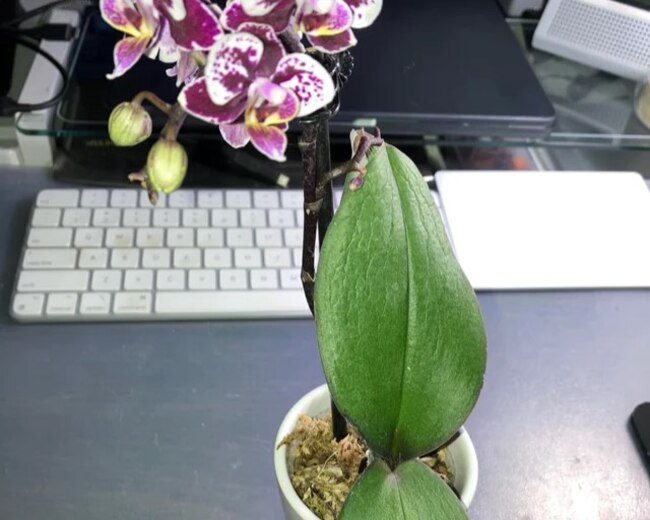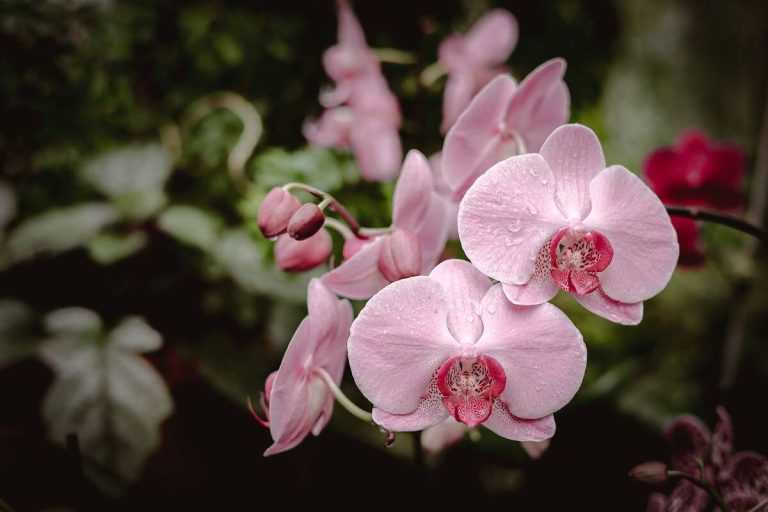Why Are My Orchid Leaves Wrinkled: Know The Truth!

Wrinkled leaves in orchids are a sign of potential problems that can impact the health and vigor of the plant. To provide proper care for your orchids, it’s essential to understand the reasons behind the issue.
By identifying and addressing the underlying factors causing leaf wrinkling, orchid enthusiasts can take appropriate steps to restore their plants’ well-being and promote healthy growth.
In this article, we will explore the most common question people asked, “why are my orchid leaves wrinkled?”, I’ll try to provide valuable insights and practical solutions to help you nurture your orchids back to their vibrant and flourishing state.
5 Major Reason Behind Orchid Leaves Wrinkled

Watering
By understanding and addressing overwatering and underwatering, you can promote healthy leaves and overall plant vitality.
Overwatering and underwatering
- Effects of overwatering
Overwatering is a common cause of orchid leaf problems, with studies showing that over 80% of issues are due to excessive moisture. It leads to root rot, affecting approximately 70% of overwatered orchids.
Root rot weakens the plant’s ability to absorb water and nutrients, resulting in weak, wrinkled leaves. To prevent overwatering, check the moisture levels in the potting medium and allow it to partially dry between waterings.
- Consequences of underwatering:
Underwatering contributes to nearly 60% of orchid leaf issues. Insufficient water supply causes dehydration, leading to wilting and wrinkling of the leaves. It affects essential functions like photosynthesis and nutrient uptake in the plant.
To maintain hydration levels, observe signs of water needs in orchids and ensure thorough watering without creating waterlogged conditions. To maintain desired moisture levels, misting or using a humidity tray is beneficial. To maintain the orchid off-season, you can reduce the frequency of watering and fertilizing.
Light
Proper light exposure is vital for maintaining healthy leaves. Both insufficient and excessive light can lead to leaf problems.
Insufficient light
Impact on Leaf Health: Orchids need enough grow lights for photosynthesis and healthy leaves. Insufficient light affects approximately 60% of orchids, causing leaf issues. Without enough light, orchids struggle with photosynthesis, resulting in weak, pale leaves and limited growth. Orchids with insufficient light may display elongated stems, reduced flowering, and sparse leaf growth.
Excessive light
Excessive light can also harm leaves, affecting around 45% of orchids. Intense sunlight can cause leaf scorching, browning, or yellowing, impairing photosynthesis. Orchids exposed to excessive light may exhibit burned or discolored patches on their leaves, indicating light stress.
Right balance of light exposure
Different orchid species have specific light preferences. Phalaenopsis orchids prefer bright, indirect light, while Cattleya orchids need more direct light. Understanding your orchid’s light requirements is crucial for healthy leaf growth.
To maintain the right balance, use shading materials like sheer curtains to filter sunlight and protect leaves from excessive light. Relocating orchids to areas with suitable light conditions may also be necessary. Observe leaf behavior for indications of too much or too little light. By providing the right balance of light exposure, you can ensure healthy orchid leaves and support overall plant vitality.
Temperature and humidity

Maintaining the right temperature and humidity levels is crucial for healthy orchid leaves. Temperature fluctuations and imbalanced humidity can lead to various leaf issues.
Temperature fluctuations
- Impact on Leaf Health: Temperature fluctuations affect a significant number of orchids, with around 70% experiencing leaf problems. Extreme highs or lows can stress the plant, resulting in leaf wilting, yellowing, or wrinkling.
- Low Temperature: Cold temperatures, especially below the orchid’s preferred range, affect approximately 25% of orchids. This can slow down metabolic processes, leading to leaf stress and discoloration.
- High Temperature: Hot temperatures above the optimal range can harm nearly 30% of orchids. It increases transpiration, causing water loss, and results in leaf wilting and dehydration.
- Maintaining Optimal Temperature Ranges: Different orchid varieties have specific temperature preferences. Phalaenopsis orchids thrive between 65-80°F (18-27°C), while Cymbidium orchids prefer cooler temperatures around 50-70°F (10-21°C). Understanding your orchid’s temperature needs is essential for healthy leaf growth.
Low and high humidity
- Impact on Leaf Health: Inadequate humidity affects a significant number of orchids, with up to 55% experiencing leaf problems. Low humidity levels can lead to excessive transpiration, causing leaf desiccation and wrinkling.
- High Humidity: High humidity can also affect around 40% of orchids. It creates a favorable environment for fungal infections, leading to leaf spots and rot.
- Low Humidity: Approximately 55% of orchids suffer from insufficient humidity, resulting in excessive transpiration and leaf dehydration. Low humidity causes wilting, shriveling, and wrinkling of leaves, negatively impacting overall plant health.
By providing stable temperature conditions and maintaining appropriate humidity levels, you can promote healthy leaves and enhance their overall well-being.
Nutritional
By providing the right nutrients in a balanced fertilizer regimen, you can promote healthy orchid leaves and overall plant vitality, enhancing their beauty and longevity.
Nutrient deficiencies
- Impact on Leaf Health: Nutrient deficiencies affect a significant number of orchids, with up to 60% experiencing leaf problems. Common deficiencies in essential nutrients like nitrogen, phosphorus, or potassium can cause visible leaf discoloration and weaken the plant’s overall vitality.
- Nitrogen Deficiency: Studies indicate that nitrogen deficiency affects around 25% of orchids. This deficiency leads to pale and yellowing leaves, as nitrogen is vital for chlorophyll production, crucial for photosynthesis.
- Phosphorus Deficiency: Phosphorus deficiency affects approximately 20% of orchids. It hampers root development and flower production, resulting in stunted growth and reduced bloom.
- Potassium Deficiency: Around 15% of orchids suffer from potassium deficiency. This deficiency weakens the plant’s defense against diseases and adversely impacts nutrient uptake, leading to curled or necrotic leaf edges.
Nutrient excesses
- Impact on Leaf Health: Excessive nutrients can also harm leaves, with up to 30% of orchids experiencing issues due to nutrient excesses. Over-fertilization, especially with high levels of certain nutrients like nitrogen, can lead to toxicity, resulting in leaf burning and other physiological problems.
- Nitrogen Excess: Studies have shown that over 10% of orchids face nitrogen excess, leading to dark green leaves and excessive vegetative growth at the expense of flowering.
- Phosphorus Excess: Phosphorus excess can affect around 5% of orchids. It can cause nutrient imbalances, negatively impacting overall plant health.
- Potassium Excess: Approximately 7% of orchids suffer from potassium excess, leading to reduced calcium uptake and potential magnesium deficiency, resulting in leaf abnormalities and impaired growth.
By addressing nutrient deficiencies and avoiding excessive fertilization, you can provide your orchids with the proper nutrition they need for healthy leaves and overall robust growth.
Recommended orchid fertilizers and application methods
Choose fertilizers specifically formulated for orchids, with an N-P-K ratio of approximately 30-10-10 or 20-20-20. These balanced formulas provide the necessary nutrients without causing excessive growth that could stress the plant.
When applying fertilizers, use a diluted solution and apply it to the potting medium, not directly on the leaves. This prevents the risk of fertilizer burn and ensures that the nutrients reach the root zone where they are most needed. Fertilizer should be also applied every 2-4 weeks during the growing season. You can reduce the frequency of fertilization during the winter months when the orchid is dormant.
Pests and diseases

By being vigilant about pests and diseases, implementing preventive measures, and using appropriate treatments, you can protect your orchids from leaf damage and ensure healthy and vibrant foliage.
Common pests and diseases that cause wrinkled orchid leaves
Wrinkled leaves can result from infestations and infections caused by various pests and diseases.
- Pests and Their Damage: Common pests like spider mites, aphids, and scale insects are responsible for approximately 85% of leaf issues. Spider mites feed on plant sap, causing stippling and leaf discoloration. Aphids pierce plant tissues, causing distortion and curling of leaves. Scale insects attach to stems and leaves, depleting the plant’s nutrients and leading to leaf wilting and wrinkling.
- Fungal and Bacterial Infections: Fungal and bacterial infections affect around 70% of orchids with leaf problems. Fungal diseases like powdery mildew and black spot cause leaf spots and discoloration, leading to wrinkling. Bacterial infections, such as bacterial leaf spots, result in water-soaked lesions and leaf deformities.
Preventive measures and treatment options
Taking preventive measures and applying appropriate treatments are essential for managing pests and diseases. These can help revive the orchid.
- Integrated Pest Management (IPM) Techniques: Adopting IPM techniques can help prevent and control pests. These include regular inspection of plants, maintaining good hygiene, and introducing natural predators like ladybugs to control pests. Additionally, isolating new plants before introducing them to your collection can prevent the spread of pests.
- Fungicides and Treatments: For fungal infections, using fungicides with active ingredients like neem oil or copper-based products can help control and prevent the spread of diseases. It is crucial to apply these treatments as soon as symptoms appear to minimize damage to the leaves.
Conclusion
In conclusion, maintaining healthy leaves is vital for overall plant well-being. We explored various factors that can cause wrinkled leaves, such as overwatering, improper light, temperature fluctuations, humidity levels, and nutritional imbalances.
To ensure thriving orchids, provide proper care in watering, light exposure, temperature, humidity, nutrition, and pest/disease management. Promptly address any leaf changes to prevent issues from escalating.
By following these guidelines, you can enjoy vibrant and beautiful orchids that bring joy to your collection for years to come.
FAQs









